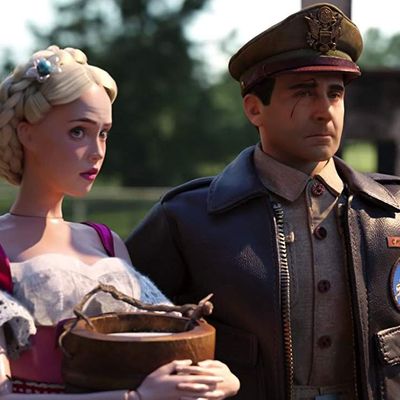
“Mark Hogancamp is a photographer and storyteller, but prefers to think of himself as a film director.” So reads the opening line of the artist bio for Hogancamp, made art-world famous in 2006 for his elaborately realized miniature WWII tableaux, indie-documentary famous, and now mainstream-holiday-movie famous in 2018, courtesy of director Robert Zemeckis. Though Hogancamp’s medium is technically photography — the works that he sells are prints and photo books — at one point in Jeff Malmberg’s 2010 documentary Marwencol, Hogancamp admits he’s been working with a camera with a broken light meter, and he figured out how to light his evocative frames through trial and error. His work is narrative and psychological and feeling, less so than technical craft. And while Zemeckis does more than Malmberg was equipped to in terms of bringing the stories and drama and violence of Marwencol to life, the whole time I found myself wondering: Why doesn’t someone let Mark make the movie?
In Zemeckis’s film, Hogancamp, played by a chain-smoking, cargo-short-wearing Steve Carell, is still working through the aftermath of the 2000 beating that left him without most of his memory, and for a while, his ability to speak and walk. Marwen, the 1:6 scale Belgian village that sits outside his trailer home in Kingston, New York, is already fully operational, populated by Mark’s WWII fighter pilot doll proxy, and a bevy of ferocious, armed-to-the-teeth women, each a stand-in for various characters in Mark’s real life. (They are voiced and embodied by Janelle Monáe, Diane Kruger, Merritt Wever, Eiza González, and a bizarrely, cartoonishly Russian Gwendoline Christie.) The film opens with a confrontation between the residents of Marwen and a crew of perennially invading Nazis, brought to cinematic but still stiffly jointed life in the movie in Mark’s mind. But we are soon yanked back out to the mundane world human Mark inhabits — post-hospital, post-rehab, but still very much in recovery from his trauma.
Potential salvation comes in the form of a new neighbor Nicol (Leslie Mann), whom Mark immediately becomes infatuated with, and soon immortalizes in his village along with the rest of the women in his life, casting her as his doll-Mark’s new love interest. He and Nicol become friends, and she is cautiously understanding of her role in his art, but it’s clear some boundaries will need to be set before someone gets hurt. Meanwhile, Mark’s friends and lawyer try to help him work up the courage to appear in court and testify against the men who attacked him, the idea of which still sends him into panic attacks and to his bottle of pain pills.
The Marwencol documentary saved the reveal of Mark’s cross-dressing as a third-act twist, possibly to its detriment. The least that can be said for Zemeckis’s adaptation is its willingness to embrace that queerness from the get-go. The bar attack, Hogancamp learned after the fact, was in response to him discussing his love of women’s clothing at a bar, and getting the perpetrators tried for a hate crime comprises much of the driving drama of Marwen. But if this is all starting to sound like … a lot, then I’m conveying it accurately: Welcome to Marwen is a totally confounding movie. None of this is because of Hogancamp’s actual story, which remains rich and wild and full of pathos, nor Carell’s performance, which is subtle and wounded and resists all mawkish special-man tics it could have lapsed into. But the frame of a Robert Zemeckis–directed Inspirational True Story and the syrupy Alan Silvestri score that blankets it are just too many layers of abstraction over a story that already contains multitudes.
We should perhaps be suspicious when the art made about an artist begins to overshadow the artist’s actual work. The cyclical drama of Marwencol, as one can gather from Hogancamp’s work and the bits of it we see in both Malmberg’s and Zemeckis’s films, is a totally engrossing blend of violence and sadism, sex, masculinity, matriarchy, and magic. It’s repeated over and over again that the project is Hogancamp’s form of therapy and self-excavation, but isn’t most art, at some point or another? There’s so much more going on here that a story of art merely mirroring life can’t capture, and I found myself wanting, at the very least, the surreal, tragic, kinky WWII movie that Hogancamp has been writing through his art for the last two decades. That movie would tell us more about the artist, sure, but it would also perhaps have a chance to be about more than Mark Hogancamp’s specific circumstance — about the violence and hang-ups and trauma of the world that created that circumstance.

